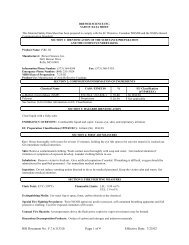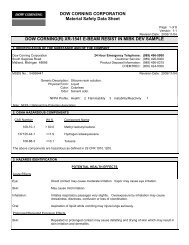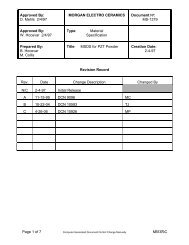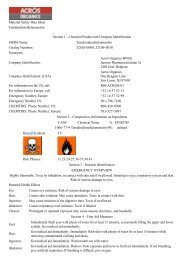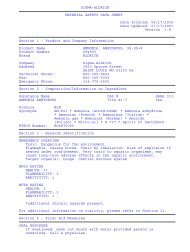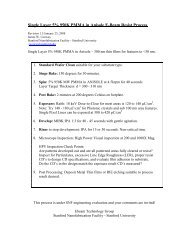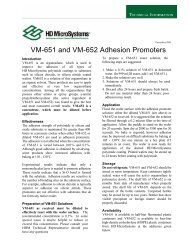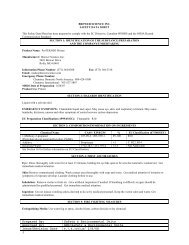MSDS M10 - Stanford Nanofabrication Facility
MSDS M10 - Stanford Nanofabrication Facility
MSDS M10 - Stanford Nanofabrication Facility
You also want an ePaper? Increase the reach of your titles
YUMPU automatically turns print PDFs into web optimized ePapers that Google loves.
Beryllium Solid <strong>MSDS</strong> No. <strong>M10</strong> January 1, 2010<br />
7. HANDLING AND STORAGE<br />
7.1 HANDLING<br />
Particulate may enter the body through cuts, abrasions or other wounds on the surface of the skin. Wear<br />
gloves when handling parts with loose surface particulate or sharp edges.<br />
7.2 STORAGE<br />
Store in a dry area.<br />
8. EXPOSURE CONTROLS, PERSONAL PROTECTION<br />
8.1 VENTILATION AND ENGINEERING CONTROLS<br />
Whenever possible, the use of local exhaust ventilation or other engineering controls is the preferred method<br />
of controlling exposure to airborne particulate. Where utilized, exhaust inlets to the ventilation system must be<br />
positioned as close as possible to the source of airborne generation. Avoid disruption of the airflow in the area<br />
of a local exhaust inlet by equipment such as a man-cooling fan. Check ventilation equipment regularly to<br />
ensure it is functioning properly. Provide training on the use and operation of ventilation to all users. Use<br />
qualified professionals to design and install ventilation systems.<br />
8.2 WORK PRACTICES<br />
Develop work practices and procedures that prevent particulate from coming in contact with worker skin, hair,<br />
or personal clothing. If work practices and/or procedures are ineffective in controlling airborne exposure or<br />
visual particulate from deposition on skin, hair, or clothing, provide appropriate cleaning/washing facilities.<br />
Procedures should be written that clearly communicate the facility’s requirements for protective clothing and<br />
personal hygiene. These clothing and personal hygiene requirements help keep particulate from being spread<br />
to non-production areas or from being taken home by the worker. Never use compressed air to clean work<br />
clothing or other surfaces.<br />
Fabrication processes may leave a residue of particulate on the surface of parts, products or equipment that<br />
could result in employee exposure during subsequent material handling activities. As necessary, clean loose<br />
particulate from parts between processing steps. As a standard hygiene practice, wash hands before eating or<br />
smoking.<br />
To prevent exposure, remove surface scale or oxidation formed on cast or heat treated products in an<br />
adequately ventilated process prior to working the surface.<br />
8.3 WET METHODS<br />
Machining operations conducted under a flood of liquid coolant require complete hooded containment and<br />
local exhaust ventilation. Openings into the hood must be baffled to prevent release of fast moving particulate.<br />
The cycling through a machine of liquid lubricant/coolant containing finely divided beryllium particulate in<br />
suspension can result in the concentration building to a point where the particulate may become airborne<br />
during use. Prevent coolant from splashing onto floor areas, external structures or operators’ clothing. Utilize<br />
a coolant filtering system to remove particulate from the coolant.<br />
8.4 RESPIRATORY PROTECTION<br />
When airborne exposures exceed or have the potential to exceed the occupational limits shown in Section<br />
8.15, approved respirators must be used as specified by an Industrial Hygienist or other qualified professional.<br />
Respirator users must be medically evaluated to determine if they are physically capable of wearing a<br />
respirator. Quantitative and/or qualitative fit testing and respirator training must be satisfactorily completed by<br />
Page 5 of 11




